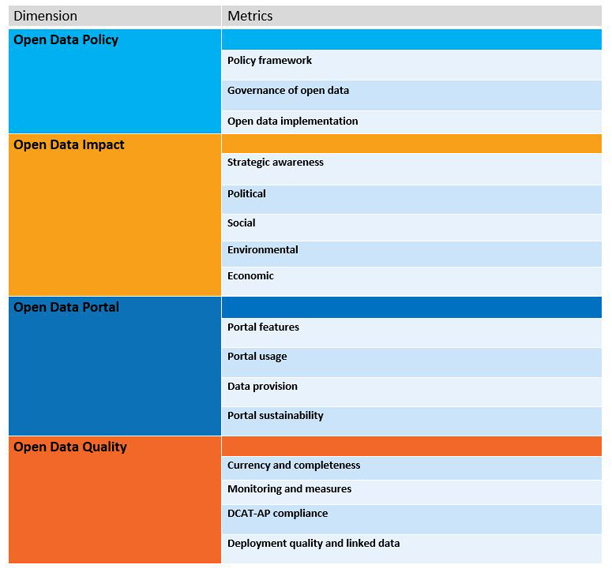The measurement of open data maturity in Europe
Find out how the European Data Portal measures open data maturity
Open data maturity
Open data has been identified as a fundamental resource for governments, businesses and civil society. In 2015, we launched the European Data Portal to improve access to open data from European countries and to foster high-quality public data publication at national, regional, and local level. Within this scope, we have been conducting our annual landscaping exercise to assess European countries' maturity in terms of open data. This landscaping exercise offers a benchmark to assess what the state of play of open data in Europe is, where European countries stand with regard to open data, and what progress countries have made. The results of these studies are summarised in yearly reports (2015, 2016, 2017 and 2018). In addition, the results are shown in the open data maturity dashboard, a tool that provides an easy and playful way to compare countries' level of open data maturity.
A mature methodology to measure open data maturity
When we started the annual open data landscaping exercise in 2015, the open data maturity measurement was built on two key indicators: Open Data Readiness and Portal Maturity. These indicators respectively cover the policy developments at country level and the features of the national open data portals. To better reflect the latest open data developments taking place across Europe as well as at EU level, we updated the methodology last year, in 2018. The revised measurement sets a stronger focus on the reuse and impact of open data and its quality by introducing two new indicators: Open Data Impact and Open Data Quality. By capturing and measuring these two new indicators, there is tangible evidence of the impact that can be derived through open data and the benefits of increasing the quality of both metadata and data. This year, in 2019, we further developed and improved the questionnaire. The developments in the questionnaire reflect the progress in the European countries, the developments at EU level - such as the recast of the PSI Directive of 2013 - as well as national and EU priorities, such as the focus on real-time access to dynamic data and enabling smarter cities and countries.
Open Data Policy (previously Open Data Readiness)
The first dimension "Open Data Policy" focuses on the presence of specific policies and strategies to foster open data at national level. The dimension assesses countries' inclusive governance structures that allow the participation of private and public-private actors, as well as implementation measures that enable open data initiatives at national, regional, and local levels. Furthermore, the "Open Data Policy" dimension focuses on training schemes that enhance the data literacy skills of the civil servants working with data as well as harvesting mechanisms that foster the discoverability of all open data available in a country.
Open Data Impact
The second dimension "Open Data Impact" assesses the level of understanding of open data reuse among public sector bodies, the activities performed to monitor the reuse, and the impact derived by it. Beyond this first layer of "strategic awareness", the impact dimension focusses on four areas of sectoral impact: political, social, environmental, and economic. Within the political, social and environmental areas, the "Open Data Impact" dimension examines applications, products, services, and civil society initiatives and the extent to which the reuse of open data is monitored. Within the economic area, the "Open Data Impact" dimension examines studies that demonstrate the micro and macro-economic value of open data, as well as the efficiency gains derived for the public sector.
Open Data Portal (previously Portal Maturity)
The third dimension "Open Data Portal" focuses on advanced portal features that enable users to access open data and features that enhance the interaction between publishers and re-users, e.g. via forum and discussion boards. Additionally, the dimension assesses the extent to which portal managers use analytics tools to better understand their users' needs and behaviour and update the portals in line with the insights gained from these analyses. Furthermore, the dimension assesses the open data coverage across different domains, as well as the approach and measures in place to ensure a portal's sustainability.
Open Data Quality
The fourth dimension "Open Data Quality" focuses on the measures adopted by portal managers to ensure the systematic harvesting of data sources from across the country. The dimension assesses the monitoring of compliance with the DCAT-AP metadata standard and the extent to which data and metadata are up-to-date and complete. The "Open Data Quality" dimension provides incentives for portal managers and policy makers to adopt best practices, including linked data elements such as universal Uniform Resource Identifiers (URI).
The four dimensions and their metrics are shown in the table below:

What to expect in 2019?
In March 2019, we sent out the landscaping questionnaire to national open data representatives from the European Union Member States and the EFTA countries to assess the countries' maturity on the four open data dimensions. After analysing the data and evaluating the answers with the countries, the Open Data Maturity Report 2019 will be published in November 2019! In the meantime, you can take a look at the countries' performance from our previous open data maturity studies or read the Open Data Maturity in Europe 2018 report. We also encourage you to share your thoughts and opinions on open data maturity with us via mail, Twitter, Facebook or LinkedIn.
